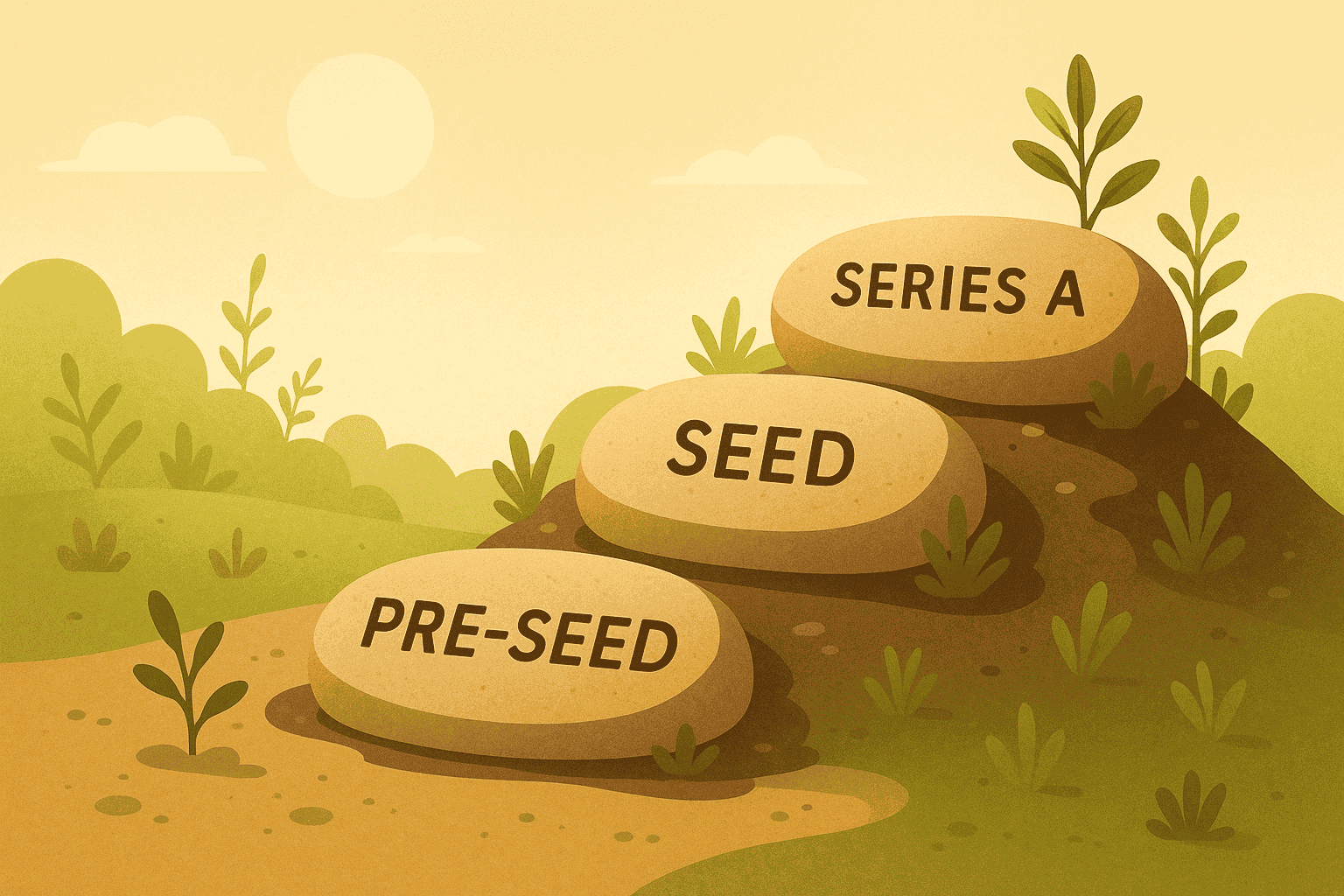5 Steps for Competitive Landscape Analysis
Competitive landscape analysis is a must for startups and investors looking to make informed decisions. The process involves identifying competitors, gathering data, and turning insights into actionable plans. Here’s the gist:
Understand competitors: Find and categorize direct, indirect, emerging, and substitute competitors. Use tools like Google Keyword Planner, social media, and industry reports.
Collect data: Study competitor websites, financials, customer feedback, and job postings. Look for pricing, product features, and market positioning.
Analyze strengths and weaknesses: Use SWOT analysis to assess competitors' advantages, gaps, and threats. Benchmark their offerings to spot opportunities.
Find market gaps: Identify unmet customer needs, pricing gaps, and underserved demographics.
Take action: Refine your value proposition, set measurable goals, and keep monitoring the market.
This approach helps startups position themselves effectively and gives investors a clear view of market opportunities.
Steven Morley: How to Do Competitor Analysis for Your Startup
Step 1: Find and Categorize Competitors
The first step in analyzing your competitive landscape is identifying and categorizing your competitors. Think of this as laying the groundwork for everything else - getting this right will make the rest of your analysis much smoother.
How to Find Competitors
Start by researching keywords that your customers might use to find solutions like yours. Tools like Google Keyword Planner, SEMrush, and Ahrefs can help you uncover companies targeting the same terms. Don’t just focus on organic search results - paid ads can also reveal key players in your space.
Next, dive into industry reports and market research. Organizations such as Gartner, Forrester, and CB Insights regularly publish reports that highlight key players in different sectors. These reports often include valuable details like market share, funding rounds, and profiles of emerging companies.
Social media monitoring is another great way to spot competitors. Platforms like LinkedIn, Twitter, and Reddit are often buzzing with industry conversations. Look for mentions of companies addressing similar problems. Tools like Hootsuite Insights or Sprout Social can help track these mentions and uncover trends.
For tech startups, app stores and software directories are goldmines of information. Browse categories on the Apple App Store, Google Play Store, or platforms like G2, Capterra, and Product Hunt. These platforms make it easy to find established competitors as well as up-and-coming solutions.
Patent and trademark searches can provide a sneak peek at companies developing similar technologies, often long before their products hit the market. Use the USPTO database to uncover intellectual property activity that might signal future competition.
Finally, dig into customer feedback and reviews on sites like Trustpilot, Glassdoor, or industry-specific review platforms. These reviews often mention alternative products, giving you firsthand insight into competitors’ strengths and weaknesses.
Categorizing Competitors
Once you’ve identified potential competitors, the next step is organizing them into categories. This helps you approach the competitive landscape strategically. Competitors generally fall into these four categories:
Direct competitors: These are companies offering nearly identical solutions to the same target audience. They solve the same problem in a similar way and compete for the same customers. For example, if you’re a project management software startup, your direct competitors would be other project management platforms targeting the same industry or company size.
Indirect competitors: These companies address the same customer need but take a different approach. They might serve a broader audience or use alternative methods to solve the problem. For instance, a video conferencing startup might view email, phone calls, or in-person meetings as indirect competitors since they all enable communication.
Emerging competitors: These are potential future threats. They may not be major players yet but show signs of growth or innovation that could disrupt the market. This category includes startups with new technologies or business models that could change how customers behave.
Substitute competitors: These offer completely different solutions that customers might choose instead. For example, a meal delivery service might see grocery stores, cooking at home, or dining out as substitutes.
When categorizing, consider factors like target audience overlap, pricing strategies, distribution methods, and core value propositions. Sometimes, a competitor might seem direct because of similar features but actually targets a different customer segment, making them indirect instead.
To keep track of everything, create a simple spreadsheet or document. List each competitor, their category, a brief description, and what sets them apart. This will serve as your go-to reference as you continue your competitive analysis.
Categorizing competitors also helps you spot gaps in the market where no strong players exist. These gaps can be opportunities for differentiation, especially for startups aiming to carve out a niche before larger companies catch on.
Use this categorized list as your starting point for gathering and organizing competitive data in the next phase of your analysis.
Step 2: Collect and Organize Competitive Data
Now that you’ve identified your competitors, it’s time to turn that knowledge into actionable insights. By gathering and organizing detailed information, you’ll be equipped to make smarter strategic decisions. The key here is to approach data collection methodically and ensure everything is well-structured.
Sources for Data Collection
Here’s where you can start digging for valuable information:
Company websites and marketing materials: Competitor websites are treasure troves of information. Check out their pricing models, feature lists, customer demographics, and positioning strategies. Pay close attention to their "About Us" pages, case studies, and blogs - they often highlight what sets them apart and showcase their success stories.
Financial databases and public filings: For funded companies, platforms like Crunchbase, PitchBook, and AngelList can provide details on funding rounds, valuations, and investors. If the company is public, dive into SEC filings to uncover financial performance metrics like revenue growth, profit margins, and strategic priorities outlined in annual reports.
Press releases and media coverage: Stay updated on competitor activities like product launches, partnerships, and other strategic moves. Setting up Google Alerts for competitor names can help you stay in the loop. Industry outlets like TechCrunch, VentureBeat, and niche trade publications often provide deeper insights into market strategies.
Customer interviews and surveys: Direct feedback from customers who’ve used or considered competitor products can be incredibly revealing. Ask about their experiences, what they appreciated, what fell short, and any unmet needs. This kind of primary research often uncovers insights that aren’t available publicly.
Social media monitoring: Analyzing competitor activity on platforms like Twitter, LinkedIn, and Instagram can provide real-time insights into how they engage with customers and position themselves in the market.
Job postings: Competitor job listings can reveal their focus areas, such as new technologies or target markets. For example, hiring for AI specialists might signal a push into machine learning.
With these sources in hand, the next step is to focus on the specific data points that will shape your competitive strategy.
Key Data Points to Gather
When collecting data, prioritize metrics that directly influence your decision-making process:
Financial performance indicators: Track revenue, funding amounts, burn rates, and growth patterns. For younger companies, funding rounds and the caliber of their investors can indicate early market traction.
Product and feature analysis: Create a feature matrix to compare competitor offerings. Document functionality, user experience, and technical capabilities. Include pricing tiers, free trials, and unique features to understand their value proposition.
Market positioning data: Examine how competitors define their target audience, highlight their value proposition, and frame their messaging. Look at the problems they emphasize solving and the customer testimonials they showcase - these reveal their perceived strengths and focus areas.
Sales and marketing metrics: Study their pricing strategies, distribution channels, partnerships, and customer acquisition tactics. Analyze their content marketing themes, ad spending, and participation in industry events to uncover their go-to-market approach.
Team and organizational insights: Look into leadership backgrounds, key hires, and advisory boards. Leadership experience can hint at strategic priorities, while new hires often signal where they’re building capabilities.
Customer feedback and satisfaction data: Review sites, case studies, and public testimonials can provide a real-world perspective on competitor strengths and weaknesses. Look for recurring themes in complaints or praise to identify patterns.
Using Comparison Tables
Once you’ve gathered all this data, organizing it effectively is crucial. Comparison tables are an excellent way to make complex information easier to digest and act upon. Here are some examples:
Feature comparison table: List core product features across competitors. Use checkmarks, ratings, or brief descriptions to indicate availability and quality. Include pricing details alongside features to better understand how competitors position their products in terms of value.
Company profile table: Summarize key organizational details like founding date, employee count, total funding, and headquarters location. This gives a quick snapshot of each competitor’s maturity and resources.
Financial performance table: Track revenue growth, funding milestones, and other financial metrics over time. Ensure consistency in time periods and data sources for accurate comparisons.
To make your tables even more effective, consider using color coding to highlight strengths or weaknesses. Just don’t overdo it - clarity should always come first.
Keep these tables up to date, especially for fast-changing metrics like pricing or new product launches. You might also want to create simplified versions for presentations to investors or stakeholders while maintaining detailed versions for internal use.
Step 3: Analyze Competitor Strengths and Weaknesses
Now that you’ve gathered the data, it’s time to dig deeper and turn those numbers into actionable insights. The goal here is to figure out what your competitors are doing well, where they’re falling short, and how you can position your business to stand out.
Conducting a SWOT Analysis
A SWOT analysis - short for Strengths, Weaknesses, Opportunities, and Threats - is an excellent way to evaluate each competitor’s standing. It gives you a well-rounded view of their position in the market.
Strengths: These are the areas where competitors shine. Maybe they’ve nailed brand recognition, offer cutting-edge technology, or have a strong customer base. Other strengths could include financial stability, seasoned leadership, or exclusive technologies. Look for patterns in their success metrics to understand what gives them an edge.
Weaknesses: These are the cracks in their armor. It could be anything from a clunky user experience to limited product features, high prices, or bad reviews. Pay attention to recurring complaints in customer feedback or gaps in their offerings. Sometimes, these weaknesses are subtle and only come to light through customer interviews or industry reports.
Opportunities: These are external trends or changes that competitors could use to grow, like new market trends, regulatory shifts, or untapped customer segments. Evaluate whether competitors are equipped to make the most of these opportunities based on their current resources and capabilities.
Threats: These are external challenges that could harm competitors’ performance. Think new entrants in the market, shifting customer preferences, economic uncertainty, or disruptive technologies. Understanding these threats can help you anticipate how competitors might adjust their strategies.
For the best results, conduct a SWOT analysis for each major competitor individually. This approach helps you uncover unique patterns and understand how different players tackle similar market challenges.
Benchmarking Competitor Offerings
Once you’ve assessed competitors’ strengths and weaknesses, it’s time to benchmark their offerings. This step isn’t just about comparing features - it’s about understanding how they deliver value and where you can differentiate yourself.
Product and feature benchmarking: Dive into the details of their products. How do they perform in terms of functionality, user experience, and reliability? If possible, test their products or gather feedback from users to see how they stack up in areas like ease of use, speed, and integration.
Pricing strategy analysis: Pricing isn’t just about the numbers. Look at their entire pricing model - free trials, freemium options, enterprise discounts, and contract terms. This analysis can reveal how they position themselves in the market and whether there are opportunities to offer better value.
Marketing and positioning benchmarking: Study how competitors communicate with their audience. What messaging themes do they use? What content strategies do they rely on? Check out their preferred marketing channels, participation in events, partnerships, and thought leadership efforts to see how they attract and retain customers.
Customer experience benchmarking: Examine how competitors treat their customers throughout the journey - from the first interaction to post-purchase support. This includes their website experience, onboarding process, and customer success initiatives. Spotting gaps here can help you deliver a standout experience.
Identifying Market Gaps
After benchmarking, focus on uncovering areas where competitors fall short. These gaps can be your opportunity to step in and meet customer needs in ways others haven’t.
Unmet customer needs: Look for recurring complaints or feature requests in customer feedback. Sometimes, customers reveal their pain points indirectly, like describing workarounds or using multiple tools to achieve their goals. These areas are ripe for improvement.
Geographic or demographic gaps: Competitors may dominate in one market but struggle in another. Maybe they’re strong with enterprise clients but neglect small businesses, or they’re focused on specific regions while ignoring others. These gaps can be entry points for your business.
Technology and innovation gaps: Competitors that fail to adopt new technologies or approaches leave room for others to innovate. Outdated interfaces, lack of mobile optimization, or missing integrations with popular platforms are all potential opportunities.
Service and support gaps: Poor customer service can be a major weak spot. Whether it’s slow response times, limited support options, or inadequate resources, stepping up your service game can make a big difference in competitive markets.
Pricing and value gaps: If competitors overcharge without delivering enough value - or undercharge in a way that undervalues their product - you can position yourself with a smarter pricing model or a stronger value proposition.
To effectively identify these gaps, combine hard data with qualitative insights. Numbers can show you what’s happening, but listening to customer conversations and observing the market will help you understand the why - and whether these gaps represent lasting opportunities for your business.
Step 4: Turn Insights into Actionable Plans
Your competitive analysis only becomes meaningful when it leads to action. Use the insights you’ve gathered to create strategies that fuel growth, attract investors, and set your startup apart.
Developing a Clear Value Proposition
Take what you’ve learned from your competitor analysis and refine your startup’s unique promise to the market. Start by aligning the gaps you’ve identified with your core strengths. For instance, if competitors struggle with complicated onboarding processes but your strength lies in user experience, make that your standout feature. Or, if the market lacks affordable options for a specific group, focus on your cost-effective approach as a key selling point.
Your value proposition needs to answer three essential questions for both investors and customers: What problem do you solve? How do you solve it better than anyone else? And why are you best positioned to succeed in this space?
Back up your claims with measurable results. For example, highlight how your solution reduces wait times by 30% or offers 24/7 customer support. These specifics make your value proposition more credible and persuasive.
Also, consider the market dynamics you’ve uncovered. If most competitors are targeting enterprise clients, you might find an untapped opportunity in serving mid-sized businesses. Similarly, tailoring your strategy to specific geographic or demographic niches can help you better connect with your audience.
Setting Performance Benchmarks
Use the insights from your competitive analysis to set clear, realistic performance goals that challenge your team while remaining achievable. These benchmarks not only guide your internal operations but also strengthen your case when presenting to investors.
Look at competitor data to establish baseline targets for growth, efficiency, and product development. For example, analyze their pricing models, customer acquisition strategies, and revenue patterns to shape your own financial projections. If your analysis reveals faster product development cycles or more efficient marketing channels, use these as points of differentiation in your strategy.
Create a dashboard to track progress against these benchmarks. Regularly review and adjust your targets as needed. This continuous tracking not only keeps your team aligned but also provides valuable data for investor updates and strategic planning sessions.
Step 5: Continuous Monitoring
Competitive landscapes - especially in tech - are constantly shifting. While your analysis provides a snapshot of the current market, staying ahead requires ongoing monitoring and flexibility.
Automate tools to track competitor updates, including changes in pricing, funding rounds, and team expansions. This allows you to quickly adapt your strategies to new developments.
Pay attention to product updates and customer feedback on competitor offerings. If a competitor launches a popular new feature, decide whether to develop something similar, improve your existing product, or emphasize your unique advantages.
Don’t stop at competitors - broader industry trends like regulatory changes, emerging technologies, and evolving customer preferences can reshape the market overnight. Staying informed about these trends helps you anticipate shifts and respond faster than others.
Additionally, tracking partnerships and funding activities can reveal competitors’ strategic moves. Use this knowledge to plan your next steps and maintain your edge.
Establish a structured process to evaluate new developments, decide on actions, and update your long-term strategy. Regular reviews of your competitive position - aligned with your planning cycles - ensure your approach stays relevant and your value proposition remains strong. As your startup grows and market conditions evolve, so should your strategies.
For early-stage startups, especially those working with investors like Allied Venture Partners, demonstrating consistent competitive awareness and the ability to adapt is key to building trust and ensuring long-term success. Use these insights to keep refining your strategy and staying ahead.
Let’s Recap (Conclusion)
Analyzing the competitive landscape is a critical step for startups aiming to secure investor confidence and uncover growth opportunities. By following a structured five-step process, you can transform market insights into actionable strategies that investors respect and value. Regular monitoring of the market ensures your business stays agile and ready to seize new opportunities.
This method not only supports strategic decisions in areas like product development, pricing, and resource allocation but also provides the solid data needed to back those decisions [3][4]. When you demonstrate a clear understanding of your competitive position and adapt to market shifts, you show investors that your startup is built on strong, strategic foundations [2].
For startups, the ability to anticipate market trends, create standout differentiators, and address potential weaknesses early is essential. This disciplined approach to competitive analysis helps you stay ahead of the curve and positions your business for long-term success [1][2]. For founders collaborating with investors such as Allied VC, this process becomes a powerful tool for building trust and showcasing your strategic vision.
Incorporating competitive analysis into your regular planning cycle isn't just a smart move - it's a necessity. The insights you gather today will shape the strategies that fuel your startup's growth in the future.
FAQs
How can startups use competitive landscape analysis to find market gaps and opportunities?
Startups can use competitive landscape analysis to pinpoint market gaps and uncover opportunities by studying competitors' products, strategies, and overall market positioning. This approach reveals weaknesses, unmet customer needs, and areas where a business can stand out.
To get started, focus on a few key steps: perform a SWOT analysis to assess strengths, weaknesses, opportunities, and threats, examine competitors' pricing, marketing tactics, and distribution channels, and keep an eye on industry trends. By digging into these elements, startups can strategically position themselves to fill market gaps and deliver unique value to their audience.
What tools and methods can startups use to gather competitive data, and how should they apply them?
Startups have several ways to collect competitive data, including online surveys, social listening platforms, industry reports, and website analytics tools. These tools provide valuable insights into competitors' products, pricing strategies, customer feedback, and overall market approach.
To make the most of these tools, begin by setting clear objectives for your analysis. Gather publicly accessible data in an organized manner, focusing on identifying trends and patterns. These insights can help you fine-tune your strategy and make well-informed choices that support your business goals.
How can analyzing competitors with a SWOT framework improve a startup's strategy and value proposition?
A SWOT analysis is a great way for startups to dive deep into their competition. By breaking things down into strengths, weaknesses, opportunities, and threats, startups can get a clear picture of what their competitors are doing well and where they might be falling short. This insight isn't just interesting - it's incredibly useful. It allows startups to fine-tune their own value proposition, highlighting what makes them stand out while addressing any gaps they might have.
But it doesn’t stop there. A SWOT analysis also plays a big role in planning smarter strategies. By spotting external opportunities, startups can figure out where they might gain an edge. At the same time, they can identify potential risks and come up with ways to tackle them head-on. The result? A clearer, more focused strategy that helps startups stay competitive and build a solid foundation for growth.




